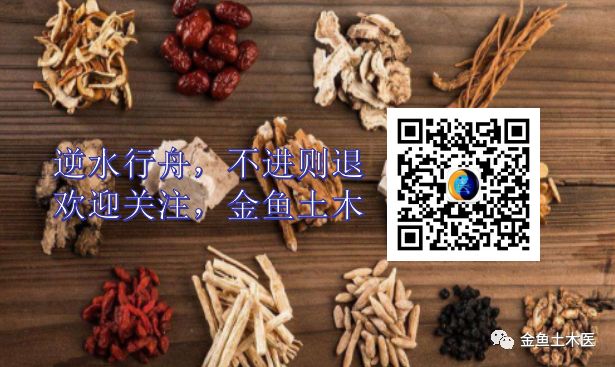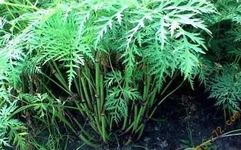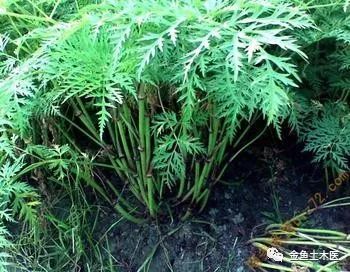
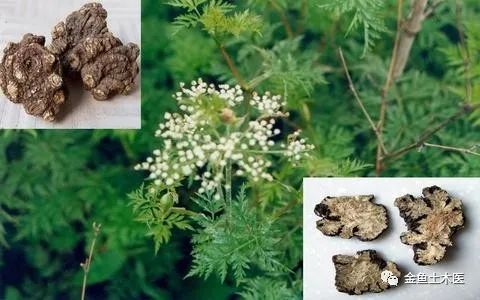
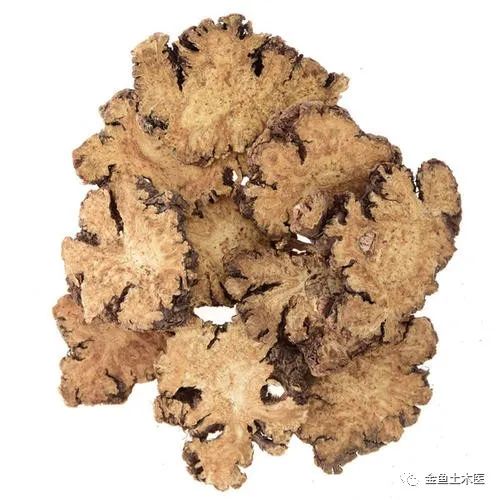
| Chuan Xiong |
|
【Herb Name】 Chuan Xiong (Ligusticum Chuanxiong) 【Source】 “Shen Nong’s Herbal Classic” 【Alias】 Shan Ju Qiong, Xiong Yao, Xiang Guo, Hu Yao, Qiong Yao, Que Nao Qiong, Jing Qiong, Guan Qiong, Sheng Chuan Jun 【Source Material】 Dried rhizome of the plant Chuan Xiong from the Umbelliferae family. 【Prescription Name】 Chuan Xiong, Jiu Chuan Xiong 【Properties】 Pungent, warm. Enters the Liver, Gallbladder, and Pericardium meridians. 【Functions】 Invigorates blood and promotes Qi circulation, dispels wind and alleviates pain. 【Clinical Applications】 1. Blood stasis and Qi stagnation, chest obstruction and heart pain, stabbing pain in the chest and flanks, swelling and pain from falls, irregular menstruation, dysmenorrhea, abdominal pain from masses. 2. Headaches. 3. Rheumatic pain. 【Dosage】 Decoction, 3-10g. 【Precautions】 This herb is pungent and warm, and should not be used in cases of headache due to Yin deficiency and Yang excess, Yin deficiency with excessive fire, red tongue and dry mouth, excessive sweating, heavy menstrual bleeding, and hemorrhagic diseases. Use with caution in pregnant women. 【Clinical Combinations】 (1) Often used with Dang Gui (Angelica Sinensis), Sheng Di Huang (Rehmannia Glutinosa), and Shao Yao (Paeonia Lactiflora) as in the Si Wu Tang (Four Substance Decoction); used for Liver Qi stagnation and blood stasis causing flank distension and pain, often combined with Xiang Fu (Cyperus Rotundus), Bai Shao (White Peony), and Chai Hu (Bupleurum). (2) As in the Chai Hu Shu Gan San (Bupleurum Powder to Spread the Liver); (3) For chest pain due to blood stasis obstructing the heart vessels; (4) Often combined with Hong Hua (Carthamus Tinctorius), Dan Shen (Salvia Miltiorrhiza), and Chi Shao (Red Peony) as in Coronary Heart Disease II Formula; (5) For abscesses and swellings due to excessive heat and Qi stagnation with blood stasis; (6) Often combined with Dang Gui, Chuan Shan Jia (Pangolin), and Zao Jiao Ci (Soapberry) as in the Tou Nong San (Disperse Pus Powder); (7) For traumatic injuries and blood stasis causing swelling and pain, often combined with Dang Gui Wei (Tail of Angelica), Tao Ren (Peach Kernel), and Mo Yao (Myrrh); (8) For external wind-cold headaches, often combined with Bai Zhi (Angelica Dahurica), Xi Xin (Asarum), and Fang Feng (Saposhnikovia Divaricata) as in the Chuan Xiong Cha Tiao San (Chuan Xiong Tea Powder). 【Related Formulas】 1. Jiu Wei Qiang Huo Tang 2. Bai Du San 3. Zai Zao San 4. Wu Ji San 5. Fang Feng Tong Sheng San 6. Si Wu Tang 7. Ba Zhen Tang 8. Tai Shan Pan Shi San 9. Suan Zao Ren Tang 10. Yang Xin Tang 11. Yue Ju Wan 12. Chai Hu Shu Gan San 13. Xue Fu Zhu Yu Tang 14. Bu Yang Huan Wu Tang 15. Wen Jing Tang 16. Sheng Hua Tang 17. Chuan Xiong Cha Tiao San 18. Da Qin Jiao Tang 19. Qiang Huo Sheng Shi Tang 20. Du Huo Ji Sheng Tang 【Chemical Components】 Chuan Xiong rhizome contains alkaloids, volatile oils, phenolic compounds, lactones, and other components. Alkaloids include Chuanxiongzine; the main components of volatile oils are ligustilide, beta-phellandrene, and butylbenzene; phenolic compounds include ferulic acid, rhein, and protocatechuic acid; lactone components include ligustilide, butenyl phthalide, and butyl phthalide. 【Pharmacological Effects】 1. Main pharmacological effects (1) Hemodynamic effects (increases coronary blood flow, vasodilation) (2) Antiplatelet aggregation and antithrombotic effects (3) Improves microcirculation 2. Other pharmacological effects (1) Sedative (2) Promotes hematopoiesis in the bone marrow 【Preparation】 Preparation methods: 1. Chuan Xiong: Take the raw material, remove impurities, separate by size, wash clean, soak in water until the skin can be easily pierced by a fingernail, take out, moisten thoroughly, slice thinly, and dry. Sift out debris. 2. Jiu Chuan Xiong: Take Chuan Xiong slices, mix with a specified amount of yellow wine, let it sit to absorb, and after the wine is absorbed, place in a frying container, heat gently until a yellow color is achieved, then take out and cool. Sift out debris. For every 100kg of Chuan Xiong slices, use 10kg of yellow wine. This product contains volatile oils, so check during the moistening process to prevent oil degradation, and avoid high-temperature drying. Preparation effects: 1. Chuan Xiong: Pungent in flavor, warm in nature. Enters the Liver, Gallbladder, and Pericardium meridians. Functions to invigorate blood and promote Qi circulation, dispel wind, and alleviate pain. Commonly used raw for irregular menstruation, dysmenorrhea, abdominal pain from masses, stabbing pain in the chest and flanks, swelling and pain from falls, headaches, and rheumatic pain. 2. Jiu Chuan Xiong: Can guide the herb upward, enhancing the effects of invigorating blood and promoting Qi circulation to alleviate pain. Often used for blood stasis headaches, migraines, wind-cold-damp pain, and postpartum abdominal pain due to stasis. 【Characteristics and Identification】 【Characteristics】 This product is irregularly knotted, fist-shaped clusters, with a diameter of 2-7cm. The surface is gray-brown or brown, rough and wrinkled, with many parallel raised nodes, and a depressed round stem scar at the top. The underside and nodes have many small tuberous root scars. The texture is solid, not easily broken, with a cross-section that is yellow-white or gray-yellow, scattered with yellow-brown oil chambers, and the growth rings appear wavy. It has a strong aroma, with a bitter, pungent taste, a slight numbing sensation on the tongue, and a mild sweetness. 【Identification】 (1) The cross-section of this product shows the cork layer with more than ten rows of cells. The cortex is narrow, with scattered vascular bundles, and the cambium layer is distinct. The phloem is broad, with the cambium layer appearing wavy or irregularly polygonal. The xylem vessels are polygonal or round, mostly arranged in single rows or in a “V” shape, with occasional wood fiber bundles. The pith is relatively large. The parenchyma tissue contains many oil chambers, which are round, oval, or irregularly shaped, light yellow-brown, with smaller oil chambers near the cambium layer that gradually increase in size outward; the parenchyma cells are rich in starch granules, and some contain calcium oxalate crystals, appearing as round clusters or crystalline clusters. The powder is light yellow-brown or gray-brown. Starch granules are abundant, with single granules being oval, elongated, round, oval, or kidney-shaped, with a diameter of 5-16μm, and a length of about 21μm, with hilum points being dot-like, long-slit, or herringbone-shaped; occasional compound granules consist of 2-4 single granules. Calcium oxalate crystals are found in parenchyma cells, appearing as round clusters or crystalline clusters, with a diameter of 10-25μm. Cork cells are deep yellow-brown, appearing polygonal on the surface, slightly wavy and curved. Many oil chambers are broken, and fragments of oil chambers can occasionally be seen, with thin cell walls containing many oil droplets. The vessels are mainly spiral vessels, with reticulate vessels and ladder-like vessels also present, with a diameter of 14-50μm. (2) Take 1g of this product powder, add 5ml of petroleum ether (30-60°C), place for 10 hours, shaking occasionally, let it stand, take 1ml of the supernatant, evaporate, and add 1ml of methanol to dissolve, then add 2-3 drops of 2% 3,5-dinitrobenzoic acid methanol solution and 2 drops of saturated potassium hydroxide solution in methanol, a red-purple color appears. (3) Take 1g of this product powder, add 20ml of ether, heat under reflux for 1 hour, filter, evaporate the filtrate, and add 2ml of ethyl acetate to dissolve, as the test solution. Take 1g of Chuan Xiong reference material and prepare the reference material solution in the same way. Then take a reference solution of ligustilide A in ethyl acetate, prepared to contain 0.1mg per 1ml (placed in a brown volumetric flask), as the reference solution. Perform thin-layer chromatography, applying 10μl of each of the three solutions to the same silica gel GF254 plate, using n-hexane-ethyl acetate (3:1) as the developing agent, develop, take out, dry, and examine under ultraviolet light (254nm). In the test solution, at the corresponding positions of the reference material and reference solution, spots of the same color appear. |
——END——
For more, please follow us

